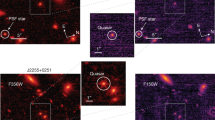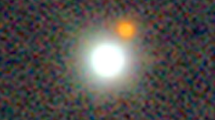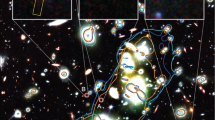Abstract
Spectroscopy of objects identified with radio sources from the Parkes Selected Regions has shown the compact, flat-spectrum source 1351–018 to be a quasar with redshift 3.71, the second most distant discovered to date. Compared with known quasars at such high redshifts, the object is optically very faint (B = 20.9), red in colour (B-R = 1.6) and is distinguishable photometrically from faint galaxies only by its relatively blue optical-infrared colour (R-K =2.1). In common with other high-redshift, radio-loud quasars, 1351–018 has weak emission lines when compared with objects selected optically through objective-prism or grism techniques. Moreover, weak-lined objects such as this may also be missed even by surveys using broad-band optical colours, which may help to explain why such searches have failed to find faint, high-redshift quasars. Because it is a member of a complete sample, 1351–018, in fact, confirms the recent suggestion1 that the quasar radio luminosity function declines for redshifts z>2. Extrapolation of the existing data predicts that the main Parkes Survey may contain about eight 8 flat-spectrum quasars with z>4.
This is a preview of subscription content, access via your institution
Access options
Subscribe to this journal
Receive 51 print issues and online access
$199.00 per year
only $3.90 per issue
Buy this article
- Purchase on Springer Link
- Instant access to full article PDF
Prices may be subject to local taxes which are calculated during checkout
Similar content being viewed by others
References
Peacock, J. A. Mon. Not. R. astr. Soc. 217, 601–631 (1985).
Wall, J. V., Shimmins, A. J. & Merkelijn, K. J. Austr. J. Phys. Astrophys. Suppl. 19, 1–68 (1971).
Downes, A. J. B., Peacock, J. A., Savage, A. & Carrie, D. R. Mon. Nor. R. astr. Soc. 218, 31–62 (1986).
Peterson, B. A., Savage, A., Jauncey, D. L. & Wright, A. E. Astrophys. J. 260, L27–L29 (1982).
McEwan, N. J., Browne, I. W. A. & Crowther, J. H. Mem. R. astr. Soc. 80, 1–59 (1975).
Savage, A., Bolton, J. G. & Trett, J. Austr. J. Phys. 35, 207–219 (1982).
Lilly, S. J. & Longair, M. S. Mon. Not. R. astr. Soc. 211, 833–855 (1984).
Lilly, S. J., Longair, M. S. & Allington-Smith, J. R. Mon. Not. astr. Soc. 215, 37–57 (1985).
Wright, A. E. Proc. 24th Liége Symp. 53–58 (University of Liége, 1983).
Wills, D. & Lynds, R. Astrophys. J. Suppl. Ser. 36, 317–358 (1978).
Hazard, C. & McMahon, R. Nature 314, 238–240 (1985).
Shanks, T., Fong, R. & Boyle, B. J. Nature 303, 156–158 (1983).
Koo, D. C. Proc. 24th Liége Symp., 240–244 (University of Liége, 1983).
Avni, Y. & Bahcall, J. N. Astrophys. J. 235, 694–716 (1980).
Hyland, A. R. & Alien, D. A. Mon. Not. R. astr. Soc. 199, 943–952 (1982).
Wright, A. E., Abies, J. G. & Alien, D. A. Mon. Not. R. astr. Soc. 205, 793–807 (1983).
Author information
Authors and Affiliations
Rights and permissions
About this article
Cite this article
Dunlop, J., Downes, A., Peacock, J. et al. A quasar with z = 3.71 and limits on the number of more distant objects. Nature 319, 564–567 (1986). https://doi.org/10.1038/319564a0
Received:
Accepted:
Issue Date:
DOI: https://doi.org/10.1038/319564a0
This article is cited by
-
The significance of spatial curvature for energy output of remote quasars
Astrophysics and Space Science (1987)
-
A QSO with redshift 3.8 found on a UK Schmidt telescope IIIa-F prism plate
Nature (1986)
Comments
By submitting a comment you agree to abide by our Terms and Community Guidelines. If you find something abusive or that does not comply with our terms or guidelines please flag it as inappropriate.



